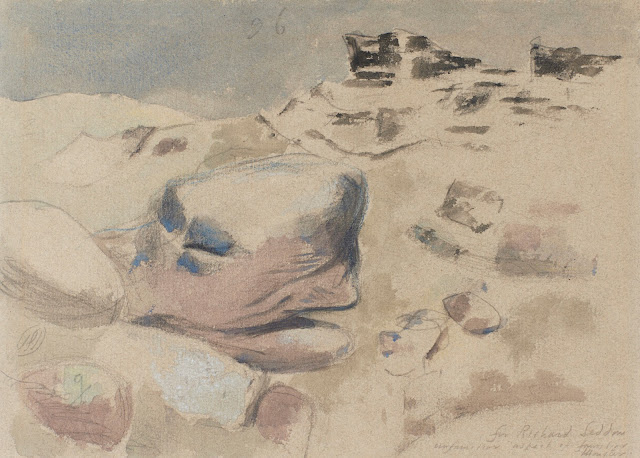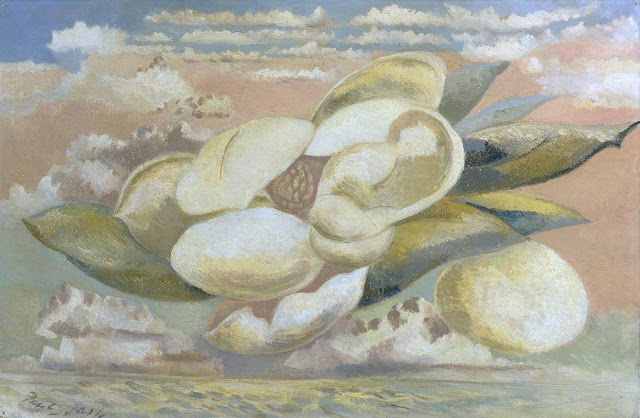
Paul Nash 1953 by William MacQuitty
© Estate of William MacQuitty
National Portrait Gallery
Paul Nash was one of the most individual British artists of his period, taking a distinguished place in the English tradition of deep attachment to the countryside whilst at the same time responding imaginatively to European modernism. He saw himself as a successor of William Blake and Turner.
After training at the Slade School he served in the First World War, was wounded, and worked as an Official War Artist, his work including some powerful views of the pitted and shattered landscape of No Man's Land that rank among the most memorable images of the conflict.
Although his later career was varied and distinguished, many critics feel that his First World War paintings mark the summit of his achievement. In the 1920s and particularly in the 1930s he was influenced by Surrealism (above all by Giorgio de Chirico, an exhibition of whose work he saw in London in 1928)
and often concentrated on mysterious aspects of the landscape.
For much of this time he lived in rural areas (Kent, Sussex, Dorset), basing his work on scenes he knew well but imaginatively transforming them. However, he continued to be involved in the London art world, and in 1933 he was the prime mover in the formation of Unit One; he also helped to organise and exhibited in the International Surrealist Exhibition in London in 1936. In the Second World War he was again an Official War Artist. He was already very sick with the asthmatic condition that killed him, but his war work included an acknowledged masterpiece, Totes Meer (Dead Sea), which portrays shot-down aircraft with their wings looking like undulating waves.
Nash was regarded as one of the finest book illustrators of his time; he also designed scenery, fabrics, and posters, and was a photographer and writer, his books including a guide to Dorset (1936). His brother John (1893–1977) was also a painter and illustrator, excelling in meticulous flower drawings for botanical publications. Like Paul he was an Official War Artist in both world wars.
This is part 7 of a 7 - part series on the works of Paul Nash:
The final part of this series features Paul Nash's photography:

1930-34 Dead Tree, Romney Marsh
30.2 x 18.2 cm
1931 Atlantic Voyage
gelatin silver photograph 31.4 x 18.4 cm (image)
Art Gallery NSW (New South Wales, Australia)
1931 Boat, Atlantic
19.3 x 30.2 cm
1931-33 Step Edge: below Nash’s garden at New House, Rye, Sussex
17.7 x 30.2 cm
1932 Breakwater, Dymchurch, Kent
gelatin silver photograph 17.8 x 30.4 cm (image)
Art Gallery NSW (New South Wales, Australia)
1932 Totems, Old Shipyard, Rye
gelatin silver print 20.5 x 13.6 cm (image)
The Cleveland Museum of Art, UK
 |
| 1933 Avebury Sentinel 30.3 x 17.3 cm |
 |
| 1933-34 Boat on the Shore, South of France 20.1 x 30.2 cm |
 |
| 1933-34 Cork Drying (France or Spain) 17.1 x 30.2 |
 |
| 1933-34 Washing drying on the beach, Nice 17.5 x 30.2 cm |
 |
| 1934 Empty Market Stalls, Ceuta, Morocco 17.6 x 30.2 cm |
 |
| 1934 The Bull Ring, Ronda, Spain gelatin silver print 14.6 x 20.5 cm (image) The Cleveland Museum of Art, UK |
 |
| 1935-36 Bench Seats, Swanage 17.3 x 30.2 cm |
 |
| 1935-36 Maiden Castle, Dorset 11 x 30.2 cm |
 |
| 1935-36 Seashore and Steps, Swanage, Dorset 17.5 x 30.3 cm |
 |
| c1935 Steps in a Field near Swanage black and white negative 8.9 x 12.8 cm Tate, London |
 |
| c1936-39 Border Plants and the Sword of a Sword-fish gelatin silver photograph 18.3 x 31.4 cm (image) Art Gallery NSW (New South Wales, Australia) |
 |
| c1936 with John Piper: The Nest of Wild Stones silver gelatin photograph 21.3 x 30 cm (image) Art Gallery NSW (New South Wales, Australia) |
 |
| 1937 Ploughed Field and Haystacks 17.4 x 30.3 cm |
 |
| c1937 The White Horse, Uffington, Berkshire 14.4 x 30.2 cm |
 |
| c1937 The White Horse, Uffington, Berkshire 17.5 x 30.2 cm |
 |
| 1938 Monster Field black and white negative |
 |
| 1938 Monster Field black and white negative |
 |
| 1938 Monster Field black and white negative 85 x 126 cm Tate, London |
 |
| 1938 Monster Field black and white negative 85 x 127 cm Tate, London |
 |
| 1938 Monster Field black and white negative 85 x 127 cm Tate, London |
 |
| 1938 Monster Field black and white negative 85 x 127 cm Tate, London |
 |
| 1940 Tail of Vickers Wellington Bomber and Hangar black and white negative 12.5 x 7.8 cm |
 |
| 1940 Vickers Wellington Bomber and Hangar black and white negative 17.9 x 12.5 cm |
 |
| 1940 Wrecked Aeroplanes at the Cowley Dump black and white negative 7.8 x 12.5 cm Tate, London |
 |
| 1940 Wrecked Aeroplanes at the Cowley Dump black and white negative 8 x 11.5 cm Tate, London |
 |
| 1940 Wrecked Aeroplanes at the Cowley Dump black and white negative 8.1 x 12.5 cm Tate, London |
 |
| 1940 Wrecked Aeroplanes at the Cowley Dump black and white negative 8.2 x 13.7 cm Tate, London |
 |
| 1940 Wrecked Aeroplanes at the Cowley Dump black and white negative 8.6 x 13.4 cm Tate, London |
 |
| 1940-41 The Box Garden, Beckley Park, Oxfordshire |
 |
| Blue Pool, near Wareham, Dorset 21.2 x 30.2 cm |
 |
| Chain and Net, John Nash’s home, Meadle, Berkshire 30.2 x 18.3 cm |
 |
| Objet Trouvé 22.2 x 30.2 cm |
 |
| Rock recessed in Grass 21.5 x 30.1 cm |
 |
| Stone Post 30.3 x 16 cm |














































